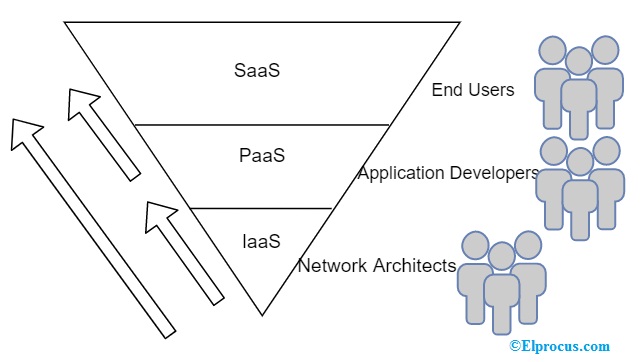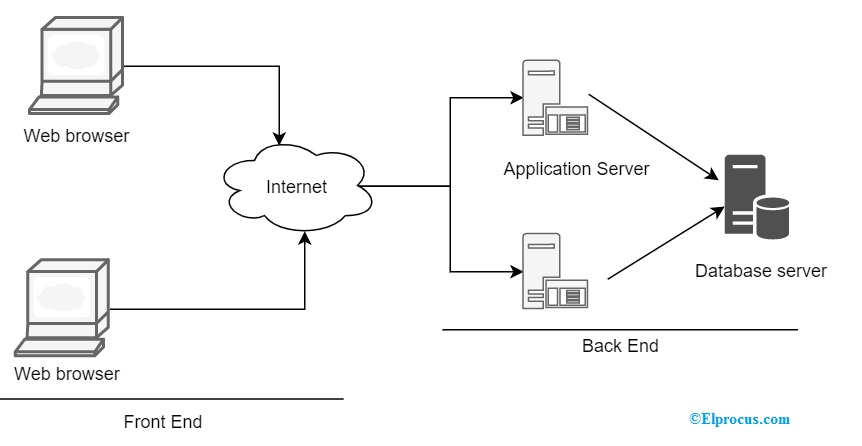Components in Cloud Computing
Cloud computing components correspond to platforms such as front end, back end, and cloud-dependent delivery and the utilized network. So, a framework of cloud computing is broadly categorized as three specifically clients, distributed servers and datacentre.
For the operation of this computing, the following three components have a big hand and the responsibilities of these components can be elucidated clearly as below:
Clients
Clients in cloud computing are in general to the operation of Local Area Networks (LAN’s). They are just the desktops where they have their place on desks. These might be also in the form of laptops, mobiles, tablets to enhance mobility. Clients hold the responsibility of interaction which pushes for the management of data on cloud servers.
Datacentre
It is an array of servers that houses the subscribed application. Progressing the IT industry has brought the concept of virtualizing servers, where the software might be installed through the utilization of various instances of virtual servers. This approach streamlines the process of managing dozens of virtual servers on multiple physical servers.
Distributed Servers
These are considered as a server where that is housed in the other location. So, the physical servers might not be housed in a similar location. Even the distributed server and the physical server appear to be in different locations, they perform as they are so close to each other.
While the other component is Cloud Applications, where it is defined as cloud computing in the form of software architecture. So, cloud applications serve as a service which operates both the hardware and software architecture.

Further, cloud computing has many other components and those come under mainly as four classifications and these components are the services of cloud computing and they can be described as follow:
Infrastructure as a Service (IaaS)
The fundamental classification of cloud computing services. This service allows for the rent of servers and virtual systems, networks, IT infrastructure and storage too. It avoids the complication behind acquiring and administering own physical servers and infrastructure. Few of the business aspects offered by IaaS are:
- Economical web hosting services
- Supports application and web servers and manage networking resources
- Increased performance on computing
- Assists in big data analysis
- Maintains huge storage, backup, and recovery
Platform as a Service (PaaS)
So, this is the one service offering an on-demand atmosphere for development, testing, deployment of many software applications. It serves as a cloud deployment environment that maintains servers, and this enables the delivery of both simple cloud applications and complex enterprise applications. Few of the business aspects offered by PaaS are:
- Stands as a platform for the development and customization of cloud-based applications.
- PaaS tools allow you to investigate and mine their information thus finding deeper insights to deliver better outcomes.
- Offers services for enhanced protection, workflow, directory, and scheduling.
Software as a Service (SaaS)
This is the approach to deliver software applications over the Internet and it might be on-demand or through a subscription basis. It allows individuals to get connected and utilize cloud applications through the Internet. SaaS offers the feature of enhancement and operation of application at a reduced cost. Few of the business aspects offered by SaaS are:
- Shows simple accessibility for complex applications
- Allows using client software in a free manner
- Mobilize workforce
- Accessibility for application information from any location
So, the other services/components of cloud computing are:
- Cloud Clients
- Cloud Services
- Cloud Applications
- Cloud Platform
- Cloud Storage
- Cloud Infrastructure
Cloud Computing Architecture
As cloud computing is more prominent in today’s digitized world, one has to be clear about its architecture. So, cloud computing architecture exactly corresponds to multiple components and sub-components that develop the entire system structure.

Cloud computing architecture comprises of two components:
- Front-End
- Back-End
Front-end corresponds to the client-side of cloud computing. This component is all about interfaces, applications and network those allow accessibility for a cloud system. The thing that has to be clear in this aspect is that not all the entire computing systems will work as a single interface.
Whereas back-end corresponds to the resources utilized by cloud computing servers. This component mainly deals with servers, security scenarios, virtualizing, data storage and many others. Also, back-end holds the responsibility to reduce traffic congestion mechanisms, and protocols that establish communication. Here, the operating system is termed as the bare metal server which is prominent with the name “hypervisor” where it utilizes well-defined protocols that allow for concurrent operation of numerous guest virtual servers. Hypervisor acts as a communication interface between its containers and for the connected world.
Apart from these, cloud-based delivery and cloud services network are also considered as cloud computing architecture. Delivery of cloud services can be done either publicly or privately through the internet. In a few cases, enterprises make use of both scenarios to deliver their services.
Advantages
In addition to delivering advantageous IT services to the current technology, this computing even shows multiple benefits for the organizations and those are:
Economical
This technology eliminates spending of huge expenses on buying hardware and software services, set up and operating external data centers. Even it minimizes the cost required for maintenance of power, storage space for servers and infrastructure.
Enhanced Scalability
Mostly, organizations with a heavy workforce face the problem of scalability. So, the cloud serves as the best solution to remove this complexity as it enables organizations to work quickly and efficiently in line with the business requirements. Cloud solutions are quintessential to meet with progressing demands. This means that when business demands enhance, cloud capacity can be easily increased without spending much. So, this level of scalability easily reduces complications.
Data Security
The most annoying problem these days for every organization is data security. Cybercrimes easily show the path for destroying an organization’s budget, secured information, and brand image.
So, to stay back from these breaches, cloud computing offers multiple secured features that ensure data protection and management. This makes sure to offer enhanced authentication, encryption and access control for data security.
Control
Being control over confidential information is crucial for every organization. Cloud allows you to have entire visibility and command over your information.
Furthermore, this technology also delivers other benefits like
- Enhanced performance
- Increased mobility and
- Speed
Thus, this is all about an overview of cloud computing. Moving in line with the current technological trends, cloud computing is implemented in many of the organizations and they gain more benefits through the implementation of this. The architecture of this enables for higher bandwidth and can be easily accessible. Get the idea of what are the emerging trends in cloud computing and digital forensics in the cloud?

Comments
Post a Comment